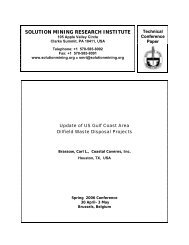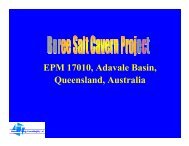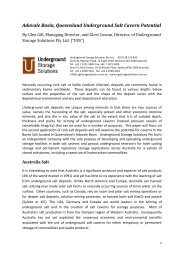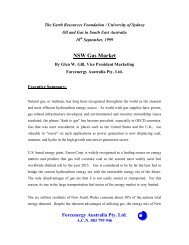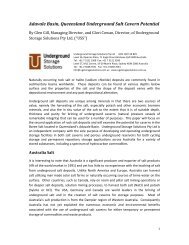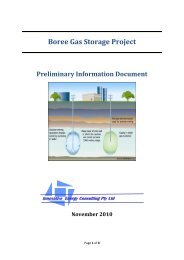Natural gas storage in salt caverns present trends in Europe
Natural gas storage in salt caverns present trends in Europe
Natural gas storage in salt caverns present trends in Europe
Create successful ePaper yourself
Turn your PDF publications into a flip-book with our unique Google optimized e-Paper software.
GILLHAUS, A. (2007): <strong>Natural</strong> <strong>gas</strong> <strong>storage</strong> <strong>in</strong> <strong>salt</strong> <strong>caverns</strong> – Present status, developments and future <strong>trends</strong> <strong>in</strong> <strong>Europe</strong><br />
5 Consequences<br />
5.1 Rock-mechanical design<br />
Modern merchant <strong>storage</strong>s place higher and quite different demands on the rock-<br />
mechanical design of the <strong>salt</strong> <strong>caverns</strong> <strong>in</strong>volved. This is because of the more frequent<br />
turnovers, the higher withdrawal rates, and particularly, the higher <strong>in</strong>jection rates.<br />
Unlike <strong>storage</strong>s constructed <strong>in</strong> the past ma<strong>in</strong>ly for seasonable balanc<strong>in</strong>g plus some peak<br />
shav<strong>in</strong>g - which were therefore only affected by one turnover per year - future merchant<br />
<strong>storage</strong>s have to cope with up to ten turnovers per annum and the associated much<br />
higher <strong>in</strong>jection and withdrawal rates. These demand<strong>in</strong>g specifications for the <strong>storage</strong>s –<br />
although probably not always required <strong>in</strong> practise – or associated with high pressure<br />
change rates ∆p/∆t, which are much higher than the previously demanded maximum<br />
figure of ∆p/∆t = 10 to 20 bar/d.<br />
The thermo-mechanical stress on the rock is another aspect: the previous much lower<br />
withdrawal rates, and especially the much lower <strong>in</strong>jection rates, led to a comparatively low<br />
<strong>gas</strong> temperature rise or drop because the surround<strong>in</strong>g <strong>salt</strong> rock is a good thermal<br />
conductor and can therefore reduce peak temperatures. Dur<strong>in</strong>g the much more rapid<br />
changes predicted <strong>in</strong> merchant <strong>storage</strong>s, there is much less time available to dissipate the<br />
heat generated. This will lead to the high temperature gradients along the walls of the<br />
cavern (Fig. 7). This could lead to cavern wall spall<strong>in</strong>g which is only acceptable if the<br />
effects are very limited. The overall effect decreases with <strong>in</strong>creas<strong>in</strong>g cavern depth due to<br />
the <strong>in</strong>creas<strong>in</strong>g tangential stress component.<br />
Figure 7: Temperature gradient <strong>in</strong> the cavern wall dependent on the <strong>gas</strong> rate.<br />
page 13 of 18




